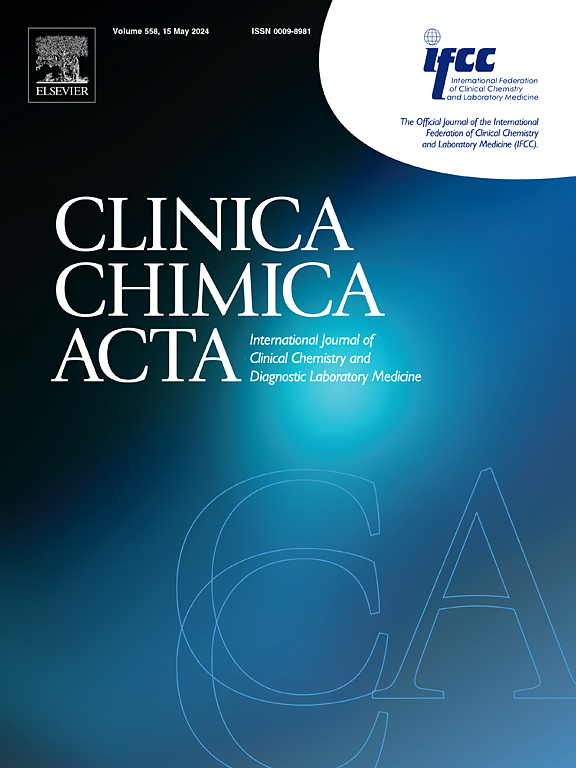RVD2 emerges as a serological marker in relation to severity and six-month clinical outcome following acute intracerebral hemorrhage: A prospective cohort study from a single academic institution
IF 3.2
3区 医学
Q2 MEDICAL LABORATORY TECHNOLOGY
引用次数: 0
Abstract
Background
Resolvin D2 (RvD2), with an anti-inflammatory activity, harbors a neuroprotective property. Here, serum RvD2 levels were detected with an attempt to explore its prognostic implication in human acute intracerebral hemorrhage (ICH).
Methods
In this prospective cohort study, serum RvD2 levels of 301 ICH patients, coupled with 100 heathy individuals, were gauged. All patients were randomly divided to two groups (200 patients in the study group and 101 in the validation group) in a 2:1 ratio. Change of serum RvD2 levels after ICH was investigated, and its correlations with National Institutes of Health Stroke Scale (NIHSS) scores, hematoma volume and poststroke six-month modified Rankin Scale (mRS) scores were determined using multivariate analysis. Its independent association with poor prognosis (mRS scores of 3–6) was uncovered in the study group and its prognostic predictive value was verified in the validation group.
Results
The serum levels of RvD2 in patients displayed a notable decline upon admission, as compared to controls. The levels exhibited independent correlations with NIHSS scores, hematoma size and mRS scores. Alternatively, RvD2 levels had independent relation to a poor prognosis after ICH. Within the framework of restricted cubic spline analysis, RvD2 levels were linearly correlated with the likelihood of poor prognosis, even adjusting for NIHSS scores and hematoma size. In the context of receiver operating characteristic (ROC) curve analysis, serum RvD2 dramatically distinguished risk of poor prognosis, with similar predictive ability to NIHSS scores and hematoma volume. By employing subgroup analysis, the relationship between RvD2 levels and poor prognosis was not obviously influenced by other parameters, such as age, sex, hypertension, and more. The integrated model containing serum RvD2, NIHSS scores and hematoma volume was visualized on a nomogram and showed high predictive performance and clinical effectiveness for poor prognosis via multiple evaluation metrics, including the Hosmer-Lemeshow test, ROC curve analysis, calibration curve analysis and decision curve analysis. Clinical usefulness of serum RvD2 was verified in the validation group.
Conclusion
Serum RvD2 levels exhibit an immediate decrease post-ICH, which could be able to accurately reflect ICH severity and efficiently prognosticate poor neurological outcomes, signifying that serum RvD2 may represent an encouraging prognostic indicator in ICH.
RVD2 成为与急性脑出血严重程度和 6 个月临床预后相关的血清学标志物:来自一家学术机构的前瞻性队列研究。
背景:Resolvin D2(RvD2)具有抗炎活性和神经保护特性。本研究检测了血清中的 RvD2 水平,试图探讨其对人类急性脑内出血(ICH)的预后影响:在这项前瞻性队列研究中,检测了 301 名 ICH 患者和 100 名健康人的血清 RvD2 水平。所有患者按 2:1 的比例随机分为两组(研究组 200 人,验证组 101 人)。研究人员调查了 ICH 后血清 RvD2 水平的变化,并通过多变量分析确定了其与美国国立卫生研究院卒中量表(NIHSS)评分、血肿体积和卒中后 6 个月改良 Rankin 量表(mRS)评分的相关性。在研究组中发现了其与不良预后(mRS 评分 3-6 分)的独立关联,在验证组中验证了其预后预测价值:结果:与对照组相比,患者入院时血清中的 RvD2 水平明显下降。该水平与 NIHSS 评分、血肿大小和 mRS 评分呈独立相关性。另外,RvD2 水平与 ICH 后的不良预后也有独立的关系。在限制性立方样条分析框架内,即使对 NIHSS 评分和血肿大小进行调整,RvD2 水平与预后不良的可能性也呈线性相关。在接受者操作特征(ROC)曲线分析中,血清 RvD2 显著区分了预后不良的风险,其预测能力与 NIHSS 评分和血肿体积相似。通过亚组分析,RvD2 水平与不良预后之间的关系并未受到年龄、性别、高血压等其他参数的明显影响。通过Hosmer-Lemeshow检验、ROC曲线分析、校准曲线分析和决策曲线分析等多种评价指标,将包含血清RvD2、NIHSS评分和血肿体积的综合模型可视化为一个提名图,并显示出其对预后不良的高预测性和临床有效性。血清 RvD2 的临床实用性在验证组中得到了验证:结论:血清 RvD2 水平在 ICH 后会立即下降,它能准确反映 ICH 的严重程度,并有效预示神经系统的不良预后,这表明血清 RvD2 可能是 ICH 的一个令人鼓舞的预后指标。
本文章由计算机程序翻译,如有差异,请以英文原文为准。
求助全文
约1分钟内获得全文
求助全文
来源期刊

Clinica Chimica Acta
医学-医学实验技术
CiteScore
10.10
自引率
2.00%
发文量
1268
审稿时长
23 days
期刊介绍:
The Official Journal of the International Federation of Clinical Chemistry and Laboratory Medicine (IFCC)
Clinica Chimica Acta is a high-quality journal which publishes original Research Communications in the field of clinical chemistry and laboratory medicine, defined as the diagnostic application of chemistry, biochemistry, immunochemistry, biochemical aspects of hematology, toxicology, and molecular biology to the study of human disease in body fluids and cells.
The objective of the journal is to publish novel information leading to a better understanding of biological mechanisms of human diseases, their prevention, diagnosis, and patient management. Reports of an applied clinical character are also welcome. Papers concerned with normal metabolic processes or with constituents of normal cells or body fluids, such as reports of experimental or clinical studies in animals, are only considered when they are clearly and directly relevant to human disease. Evaluation of commercial products have a low priority for publication, unless they are novel or represent a technological breakthrough. Studies dealing with effects of drugs and natural products and studies dealing with the redox status in various diseases are not within the journal''s scope. Development and evaluation of novel analytical methodologies where applicable to diagnostic clinical chemistry and laboratory medicine, including point-of-care testing, and topics on laboratory management and informatics will also be considered. Studies focused on emerging diagnostic technologies and (big) data analysis procedures including digitalization, mobile Health, and artificial Intelligence applied to Laboratory Medicine are also of interest.
 求助内容:
求助内容: 应助结果提醒方式:
应助结果提醒方式:


